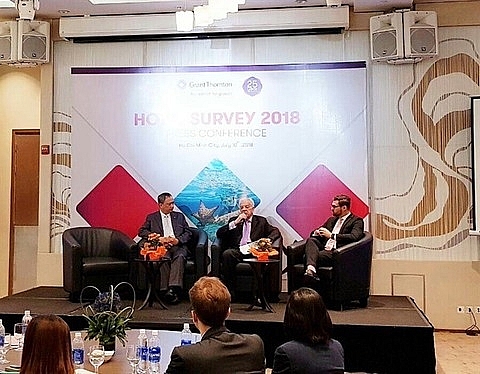Upscale hotel sector sees all-round growth in 2017
 |
| Experts talk about the performance of the Vietnam hotel industry at a press meeting on July 10 in HCM City. - VNS Photo Thu Hang |
The report marks the 15th year the US accounting and advisory firm has done research on high-end hotels and resorts in Vietnam.
After a drop in 2016, five-Star hotels made a recovery with average tariffs increasing by 4.2 per cent last year to $107.6.
Four-star hotel tariffs also rose but by less than 1 per cent, to $75.2.
All regions saw tariffs rise, with the central region achieving the highest increase of 5.7 per cent, followed by the northern region with 4.4 per cent.
Occupancy rates improved by 4.8 per cent for four-star and 5 per cent for five-star hotels.
The central region again achieved the highest increase -- 7.5 per cent -- followed by the north (6.4 per cent) and the south (2.2 per cent).
RevPAR (Revenue per available room) continued to increase, but at a different rate for each star category: 10.2 per cent for five-star and 7.6 per cent for four-star hotels.
The central region obviously achieved the highest growth, followed by the north.
The southern region ranked last with a 4.7 per cent rise.
The upscale hotels sector’s profitability continued to rise.
FIT/leisure travellers and tour groups accounted for the highest proportions of guests staying at upscale hotels, together accounting for more than 60 per cent of the total number.
The third biggest group, corporate/business travellers, saw a slight increase of 0.5 per cent.
MICE (Meetings, Incentives, Conference and Exhibits) guest numbers declined by 0.2 per cent.
Tour operators/travel agencies remained the biggest reservation channel for four- and five-star hotels (33 per cent) while online travel agencies saw a marginal increase (21.4 per cent).
Last year all participating hotels had integrated one or more digital technologies into their operations.
While digital marketing and using of data mining and analysis have become basic tools used at almost all four- and five-star hotels, the trend of applying mobile apps for guests’ personalisation and online check-in/check-out is becoming more and more popular, and increasing quickly, with more than 50 per cent of five-star and 30-40 per cent of the four-star hotels using them.
It is predicted that these digital technologies will soon take over the industry.
Vietnam’s tourism numbers continued to grow last year, in fact surpassing the Government’s expectations for a second straight year.
Tourist numbers rose by 19 per cent to 86 million in 2017, with international arrivals increasing by 29 per cent, attributed mostly to a 1.3 million increase in the number of Chinese visitors. Domestic traveller numbers increased 18 per cent.
The hotel industry, following the increase in visitor numbers, is receiving massive amounts of investment.
According to the Ministry of Culture, Sport and Tourism, last year 79 new upscale hotels opened, 10 of them five-star, with a total of 101,400 rooms.
AirBnB, an emerging player in the hospitality scene, is also seeing an increase in the number of listings, with over 16,000 places available just in and around Hanoi and HCM City.
What the stars mean:
★ Poor ★ ★ Promising ★★★ Good ★★★★ Very good ★★★★★ Exceptional
Related Contents
Latest News
More News
- TD CASA and the rise of bespoke interior design in luxury living spaces (December 03, 2025 | 14:14)
- A season of warmth at InterContinental Phu Quoc Long Beach Resort (December 02, 2025 | 16:47)
- Hilton and Sun Group lead Vietnam’s next wave of premium travel (December 01, 2025 | 10:58)
- Young artists shine in Muong Thanh drawing contest (November 24, 2025 | 11:10)
- Celebrate the festive season with tropical flavour at Angsana & Dhawa Ho Tram (November 17, 2025 | 07:33)
- Maia Spa at Fusion Resort & Villas Da Nang wins at World Luxury Spa Awards (November 14, 2025 | 17:53)
- Phu Quoc celebrates passion as well as family pride (October 27, 2025 | 09:00)
- Vietnam named among world’s top four culinary destinations (October 24, 2025 | 17:09)
- Amanoi wins Three MICHELIN Keys at 2025 awards (October 21, 2025 | 16:49)
- Tru by Hilton hotel awakens ecotourism potential of Hau Giang (October 21, 2025 | 14:53)

 Tag:
Tag:






















 Mobile Version
Mobile Version